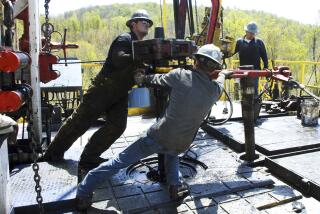Arctic Refuge Feeling the Heat as Lawmakers Press Their Cases
- Share via
WASHINGTON — When a trio of U.S. senators arrives today in the tiny Alaska village of Kaktovik (population 220; average high temperature this time of year, minus 9 degrees), the real arm-twisting begins.
The trip is a critical phase of the heavy lobbying campaign to win the precious few undecided votes in Congress to support President Bush’s favorite and most divisive energy initiative: oil drilling in the Arctic National Wildlife Refuge.
It is Bush’s toughest environmental battle, on an issue that is a major element of a national energy strategy expected to be unveiled soon by the White House.
Bush has advocated oil and gas exploration on 1.5 million acres of the 19.6-million-acre refuge in the northeast corner of Alaska as a way to reduce U.S. dependence on foreign oil. The California electricity crisis, price spikes for natural gas throughout the country and dire warnings of energy shortages this summer have increased the pressure on Congress to permit the drilling.
Foes say drilling could spoil one of the nation’s most precious wild areas, home to caribou, polar bears and more than 130 bird species. They say the drilling would do nothing to help solve the California power crisis because only 1% of the state’s electricity is produced by oil.
Sen. Frank H. Murkowski (R-Alaska), chairman of the Senate Energy and Natural Resources Committee, is leading the trip to Kaktovik to showcase Alaska support for the drilling. Interior Secretary Gale A. Norton is accompanying the group.
Alaska’s pro-drilling, three-man congressional delegation--Murkowski, Sen. Ted Stevens and Rep. Don Young, all Republicans--has taken lawmakers on tours of the refuge before. But with an ex-oilman in the White House and business-friendly Republicans in control of Capitol Hill and the White House for the first time since the Eisenhower era, the political climate to permit the drilling is better now than it has been in years.
Still, passage is far from certain. Drilling proponents suffered a setback this week when the House left out of a budget resolution $1.2 billion in payments the government expects to receive from drilling in the refuge.
Bush also acknowledged the tough fight. “I think it’s important for us to open up” the refuge, he said at a news conference Thursday. “Whether or not the Congress sees it that way is another matter.”
There might not be a vote on the issue until summer.
During their visit to Kaktovik, senators will hear from native Inupiat Eskimos who count on oil royalties to fund their schools and other services. “It’s a matter of survival for my people,” Tara Sweeney, an Ivy League-educated Inupiat, said during a recent trip to Washington, where she lobbied Congress to allow drilling.
Environmental groups are countering with their own trips to Alaska for lawmakers and with television ads, polls and biological studies. “I don’t think the public has forgotten things like the Exxon Valdez” oil tanker spill, said Robert Dewey, vice president for government relations of Defenders of Wildlife.
Exxon Valdez Still a Factor
Big Oil has kept a low profile in the lobbying battle. The pro-drilling fight has been led by Arctic Power, an Alaska-based group that receives funding from the state government and the oil industry.
The group has sought to highlight its support from Alaskans, ranging from the state’s Democratic governor to union leaders. After stops at the site of the 1989 Exxon Valdez disaster (where drilling supporters want to point to steps taken to prevent future spills) and the Prudhoe Bay oil fields--the senators will arrive in Kaktovik.
Environmentalists say the lawmakers won’t see much more than frozen tundra this time of year. “They’ll fly over it and say, ‘See, there’s nothing there,’ ” said Adam Kolton, Arctic campaign director of the Alaska Wilderness League. Environmental groups plan their own congressional tour of the refuge--a camping trip during the Fourth of July recess--when wildlife is more plentiful.
Drilling advocates defend the timing of their trip, saying exploration will take place in the winter when the caribou and bird populations have left the frigid region.
Besides Murkowski, the two other senators on this weekend’s trip are Jeff Bingaman of New Mexico, the top Democrat on the Senate Energy and Natural Resources Committee and a drilling foe; and Mark Dayton (D-Minn.), who has voiced opposition to the drilling. But more trips are planned.
Murkowski has been among the most passionate and relentless advocates of the drilling. He has taken to the Senate floor, pointer in hand, to lecture on the migratory patterns of the Porcupine caribou herd. And he has pitched drilling at the dedication of an oil tanker at a shipyard in Louisiana, home of undecided Democratic Sen. Mary Landrieu.
Last week, Murkowski directed an aide to move one of his favorite props--a picture of brown bears walking on the trans-Alaska pipeline--into a prominent position before a news conference to tout the Teamsters endorsement of drilling.
Murkowski has been pushing drilling in the refuge since 1984--and came close to winning a couple of times. A bill he supported in 1989 to permit the drilling was expected to clear a key congressional committee--when the Exxon Valdez ran aground in Prince William Sound, dumping 11 million gallons of crude oil into the water. The bill never even came up for a vote. Congress in 1995 included language in a budget bill to permit drilling in the refuge, but the measure was vetoed by President Clinton.
Murkowski said this week’s trip will give lawmakers “an opportunity to view objectively the issue of whether or not it is in the national interest to open” the refuge and to “hear from Alaskans themselves their attitude on whether or not this can be opened safely.”
Sweeney, the Inupiat who has lobbied for drilling, talks about the hardships of her early childhood, before the injection of cash from Prudhoe Bay oil fields. There were no flush toilets, health clinics or running water in Barrow, the northernmost town in the United States.
“Prior to Prudhoe Bay, we were opposed to development because we thought it would harm the caribou, but the caribou are not harmed,” she said. “My people would not be supporting development if we did not believe it can occur safely.
“Drilling in [the refuge] will preserve our ability to live within normal living standards. We don’t want to go back to living in deplorable conditions.”
Another Voice Added to Equation
Her argument seems undeniably heartfelt, though she is an Anchorage-based lobbyist for Arctic Slope Regional Corp., the company that manages the 5 million acres and oil riches in the North Slope given to the Inupiat in the Alaskan Native Plains Settlement Act of 1972.
Those who favor drilling say the Inupiat are the voice of native Alaska. But environmentalists contend that the Gwich’in, a Native American tribe that lives on the other side of the Brooks Range mountains, speak for native Alaskans.
The Gwich’in argue that drilling in the Arctic wildlife refuge would hurt their subsistence lifestyle, which depends on the caribou.
“The Arctic refuge is the sacred calving ground of the caribou,” said Donna Carroll, administrative director of the Gwich’in Steering Committee, which raises money to fight development of oil drilling in the refuge. “We’re caribou people. We rely on that area. We have to protect it. It’s our human right.”
The conflict has inspired some hardball tactics, at least on the side of the Inupiat. Reaching in to her sealskin briefcase, Sweeney produced copies of leases the Gwich’in had signed to allow exploration of oil and gas on their own land in the 1980s.
“How can you come to Washington and oppose development of the Arctic refuge when you leased your own land for development and came up dry?” Sweeney asked.
But Carroll said the issues are unrelated because the leased land was not on the migratory path of the caribou. “I’m not against drilling,” Carroll said. Acknowledging her own oil use, she added, “I drove a car to work today.”
The amount of oil under the refuge is in dispute. Federal officials have estimated that the region could yield as much as 12 billion barrels of oil. Opponents say that would not be worth the environmental risk.
The targets of the lobbying are a handful of undecided members of Congress. Although the Senate is divided 50-50 between the parties, some Republicans oppose the drilling while some Democrats support it. California Democratic Sens. Barbara Boxer and Dianne Feinstein have opposed the drilling.
Sen. John F. Kerry (D-Mass.) has pledged to stage a filibuster against drilling, a maneuver that would require 60 votes to stop. But Republican experts in the arcane Senate rules are looking at ways that would allow for approval with 51 votes.
In the House, drilling proponents are focusing their efforts on a handful of conservative “Blue Dog” Democrats and Democrats from oil-producing states.
More to Read
Sign up for Essential California
The most important California stories and recommendations in your inbox every morning.
You may occasionally receive promotional content from the Los Angeles Times.











